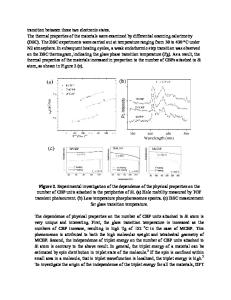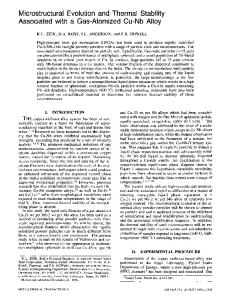Glassy materials with enhanced thermal stability
- PDF / 1,408,842 Bytes
- 6 Pages / 585 x 783 pts Page_size
- 107 Downloads / 402 Views
rming tendency Ever since the inception of academic glass research, practitioners have often wondered—what is so special about the select few melts that can bypass crystallization and be supercooled to form bulk glasses at the glass-transition temperature (Tg)? With the important strides made in glass science in the past 35 years, both in theory and experiments, we now have a wealth of new information on the crucial role of network topology in decoding the origin of the glass-forming tendency. The Phillips–Thorpe Rigidity Theory1–3 has been pivotal in elucidating the physics of network glasses. The key parameter in the theory is the number of constraints per atom, nc,, due to chemical bonds, in particular, bond-stretching and bondbending interactions. When nc = 3, glassy networks are optimally constrained, fulfilling the Maxwell criteria for rigidity (i.e., nc = 3 for three-dimensional networks). Such optimally constrained networks within the Phillips–Thorpe approach possess a mean coordination number of 2.40. At nc < 3, networks possess low-frequency floppy modes and are flexible, those with nc > 3, possess stress-creating redundant bonds and are stressed-rigid, while those with nc = 3 form networks that belong to an intermediate phase (IP). The comparative functionalities of the underlined three topological phases have evoked much interest in glass science. The first tests of these topology-driven ideas were applied to the chalcogenide glasses. These glasses represent alloys of
Group VI (S, Se) elements with Group IV (Si, Ge) or Group V (P, As) elements. An attractive feature of these elements is that their chemical bonding conforms to the 8-N bonding rule, where N represents the number of valence electrons. Thus, the coordination number r acquired by Ge, As, and Se usually is 4, 3, and 2, respectively. One can thus enumerate the mechanical constraints per atom, nc, from a knowledge of the chemical stoichiometry alone of an alloyed glass composition such as GexAsySe100–x–y.
Thermally reversing windows and birth of the IP The most unusual nature of isostatically rigid networks came to the forefront when Raman scattering measurements and modulated differential scanning calorimetry (MDSC) experiments were performed in precise compositional studies of the chalcogenides.4–6 Isostatically rigid networks are those in which optimally constrained local structures percolate across the glass sample. These experiments showed that IP networks do not form merely at one characteristic stoichiometry of rc = 2.40, but rather, over a small but finite range of connectivity, the IP window rc1 < r § < rc2, near 2.40, with sharply defined edges rc1 and rc2 representing the rigidity and stress transitions, respectively. To obtain such sharp edges, it is crucial that the alloyed melt/glass batch be highly homogeneous.7 Within the IP window, glasses possess
P. Boolchand, Department of ECS, College of Engineering and Applied Science, University of Cincinnati, USA; [email protected] B. Goodman, Department of Physics, University of Cincinna
Data Loading...











